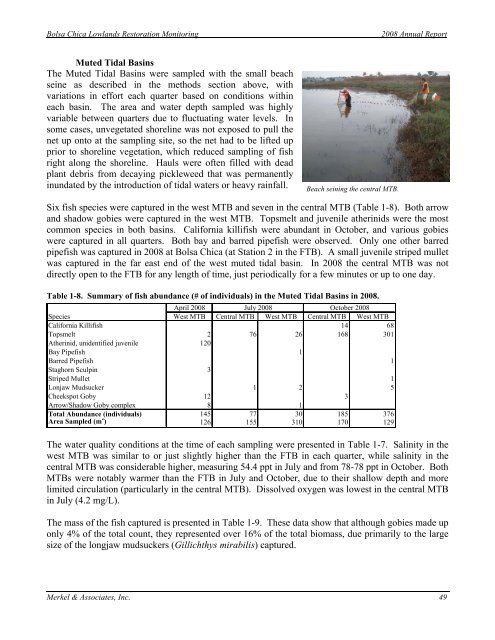2008 Annual Monitoring Report (pdf 10.9MB) - Bolsa Chica ...
2008 Annual Monitoring Report (pdf 10.9MB) - Bolsa Chica ...
2008 Annual Monitoring Report (pdf 10.9MB) - Bolsa Chica ...
You also want an ePaper? Increase the reach of your titles
YUMPU automatically turns print PDFs into web optimized ePapers that Google loves.
<strong>Bolsa</strong> <strong>Chica</strong> Lowlands Restoration <strong>Monitoring</strong><br />
<strong>2008</strong> <strong>Annual</strong> <strong>Report</strong><br />
Muted Tidal Basins<br />
The Muted Tidal Basins were sampled with the small beach<br />
seine as described in the methods section above, with<br />
variations in effort each quarter based on conditions within<br />
each basin. The area and water depth sampled was highly<br />
variable between quarters due to fluctuating water levels. In<br />
some cases, unvegetated shoreline was not exposed to pull the<br />
net up onto at the sampling site, so the net had to be lifted up<br />
prior to shoreline vegetation, which reduced sampling of fish<br />
right along the shoreline. Hauls were often filled with dead<br />
plant debris from decaying pickleweed that was permanently<br />
inundated by the introduction of tidal waters or heavy rainfall.<br />
Beach seining the central MTB.<br />
Six fish species were captured in the west MTB and seven in the central MTB (Table 1-8). Both arrow<br />
and shadow gobies were captured in the west MTB. Topsmelt and juvenile atherinids were the most<br />
common species in both basins. California killifish were abundant in October, and various gobies<br />
were captured in all quarters. Both bay and barred pipefish were observed. Only one other barred<br />
pipefish was captured in <strong>2008</strong> at <strong>Bolsa</strong> <strong>Chica</strong> (at Station 2 in the FTB). A small juvenile striped mullet<br />
was captured in the far east end of the west muted tidal basin. In <strong>2008</strong> the central MTB was not<br />
directly open to the FTB for any length of time, just periodically for a few minutes or up to one day.<br />
Table 1-8. Summary of fish abundance (# of individuals) in the Muted Tidal Basins in <strong>2008</strong>.<br />
April <strong>2008</strong><br />
July <strong>2008</strong> October <strong>2008</strong><br />
Species West MTB Central MTB West MTB Central MTB West MTB<br />
California Killifish 14 68<br />
Topsmelt 2 76 26 168 301<br />
Atherinid, unidentified juvenile 120<br />
Bay Pipefish 1<br />
Barred Pipefish 1<br />
Staghorn Sculpin 3<br />
Striped Mullet 1<br />
Lonjaw Mudsucker 1 2 5<br />
Cheekspot Goby 12 3<br />
Arrow/Shadow Goby complex 8 1<br />
Total Abundance (individuals) 145 77 30 185 376<br />
Area Sampled (m 2 ) 126 155 310 170 129<br />
The water quality conditions at the time of each sampling were presented in Table 1-7. Salinity in the<br />
west MTB was similar to or just slightly higher than the FTB in each quarter, while salinity in the<br />
central MTB was considerable higher, measuring 54.4 ppt in July and from 78-78 ppt in October. Both<br />
MTBs were notably warmer than the FTB in July and October, due to their shallow depth and more<br />
limited circulation (particularly in the central MTB). Dissolved oxygen was lowest in the central MTB<br />
in July (4.2 mg/L).<br />
The mass of the fish captured is presented in Table 1-9. These data show that although gobies made up<br />
only 4% of the total count, they represented over 16% of the total biomass, due primarily to the large<br />
size of the longjaw mudsuckers (Gillichthys mirabilis) captured.<br />
Merkel & Associates, Inc. 49






